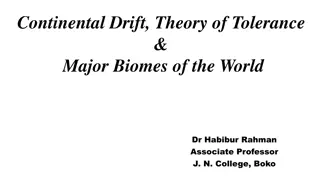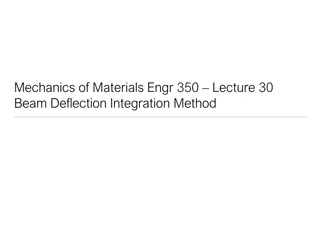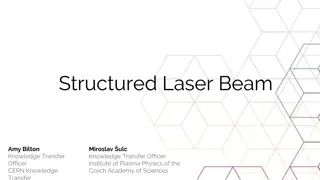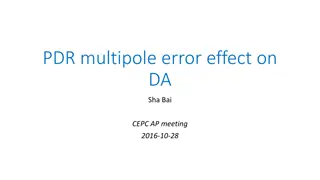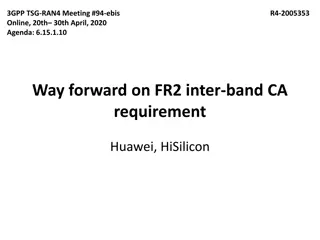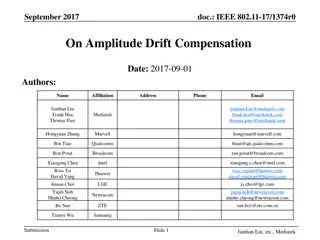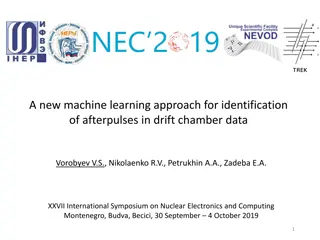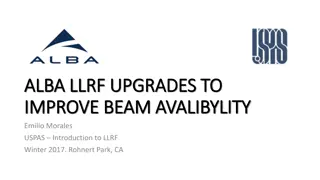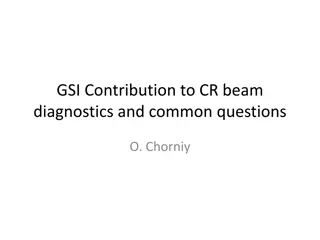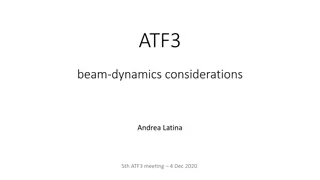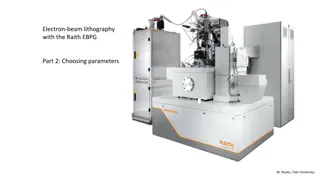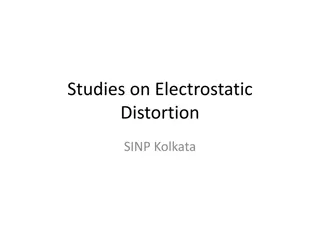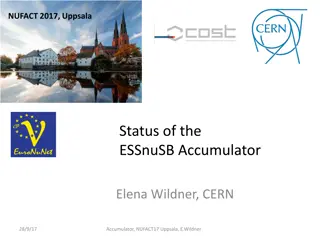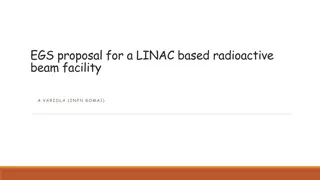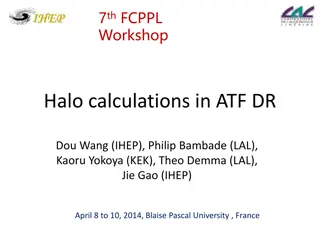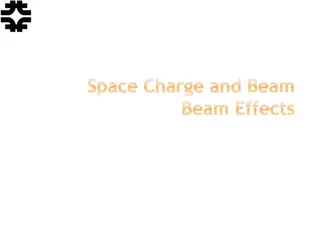Continental Drift, Theory of Tolerance & Major Biomes of the World Overview
This detailed presentation explores topics like Continental Drift, the Theory of Tolerance, and Major Biomes of the World. It covers the history of the Continental Drift theory, from Wegener to Du Toit's modifications, and delves into the various terrestrial biomes that exist, including tundra, bore
2 views • 26 slides
Beam Deflection and Integration Method in Mechanics of Materials
Understanding beam deflection through integration method involves analyzing relationships between moment, deflection, slope, and shear in a beam structure. By integrating the moment equation under certain assumptions and boundary conditions, engineers can determine deflections and solve for constant
2 views • 12 slides
Innovative Structured Laser Beam Technology for Improved Beam Propagation
An overview of a novel structured laser beam (SLB) system designed for long-distance propagation with low divergence and a small central spot size. This cost-effective method allows for easy adjustment of beam parameters and offers advantages such as self-reconstruction after obstacles, compact spot
0 views • 9 slides
Analysis of Multipole Error Effects on Beam Dynamics in CEPC Accelerator
The content discusses the impact of multipole errors on the beam dynamics at the CEPC Accelerator, focusing on sources of error, measurements, and potential effects on the beam. The analysis includes different types of multipole errors, their sources, and the resulting changes in tune and emittance
4 views • 11 slides
Correlated Head-Tail Instability in Beam-Beam Collisions
The study discusses the impact of the cross wake force and correlated head-tail instability in collisions with a large crossing angle. It delves into the mechanism of beam-beam instability, cross wake force induction, mode coupling, and particle tracking simulations. Design parameters and instabilit
1 views • 34 slides
Analysis of Beam Commissioning and Tune Evolution in 2015
This study analyzes the tune variation during beam commissioning in 2015 at the Large Hadron Collider. It includes comparisons of beam fills, bare tune analysis, evolution, and differences between beams 1 and 2. The research delves into the behavior of tune parameters, energy models, and the accurac
1 views • 9 slides
Agreements on FR2 Inter-Band Carrier Aggregation Requirements
Agreements have been reached on the RRM requirements and scaling factors for FR2 inter-band Carrier Aggregation, focusing on common beam and independent beam management. Discussions include alignment with Release 16 specifications, scenarios, and RF architectures. Interruption requirements for diffe
0 views • 8 slides
Amplitude Drift Compensation in IEEE 802.11-17/1374r0 Document
The document discusses Amplitude Drift Compensation in the context of EVM tests for IEEE 802.11 devices. It highlights the challenges posed by amplitude drift, the impact on EVM degradation, and the need for compensation mechanisms. Various authors from different affiliations contribute insights on
0 views • 6 slides
Practice Drift in Nursing: Risks and Consequences
Explore the concept of practice drift in nursing, where nurses may deviate from standards leading to unsafe practice. Learn how to identify and prevent practice drift, understand scope of practice, and adhere to state regulations. Discover the importance of following the Model Nurse Practice Act and
1 views • 35 slides
Innovative n-Type Segmented Inverted Coaxial HPGe Detector Study
Comprehensive characterization of an n-type Segmented Inverted Coaxial Point Contact (ICPC) detector by Heather Crawford at the AGATA-GRETINA collaboration meeting. The study focuses on energy resolution, drift time corrections, azimuthal angle and full position reconstruction, along with in-beam ch
0 views • 29 slides
Machine Learning Approach for Afterpulse Identification in Drift Chamber Data
A new machine learning approach is introduced for the identification of afterpulses in drift chamber data, aiming to exclude afterpulses using convolutional neural networks. The research involves the reconstruction of tracks using the histogram method, addressing the issue of afterpulses that can le
0 views • 13 slides
Managing E-Beam Drift for Semiconductor Fabrication
Explore techniques to address e-beam drift issues in semiconductor manufacturing, such as alignment using wafer marks and multi-pass writing strategies. Learn how to minimize drift problems and improve productivity in the fabrication process.
0 views • 44 slides
Beam Energy Calibration with Compton Scattering Method
The CEPC beam energy calibration with Compton scattering method led by Yongsheng Huang and the CEPC energy calibration working group involves collaborations with various institutions and organizations. The project includes detailed physics requirements, system designs, and implementation plans for b
0 views • 14 slides
Determining OBS Clock Drift Using Seismic Interferometry
Determining clock errors in Ocean Bottom Seismometers (OBSs) is crucial for accurate seismic data recording. This study presents a method using ambient seismic noise and seismic interferometry to correct clock drift in OBSs. The program developed employs Python/Fortran to analyze seismic data direct
1 views • 10 slides
Enhancing Beam Availability with ALBA LLRF Upgrades
ALBA LLRF upgrades aim to improve beam availability by implementing auto-recovery processes and feed-forward loops for RF trip compensation. The upgrades involve detuning cavities, adjusting amplitudes and phases, and enabling tuning loops to ensure smooth power delivery to the beam. Despite challen
0 views • 10 slides
GSI Contribution to CR Beam Diagnostics and Future Contracts
Contribution of GSI to CR beam diagnostics includes discussions on diagnostic devices, component status, working questions, and future contracts. Future plans involve the procurement of various devices and components required for beam diagnostics. Known demands for 400 mm diagnostics devices are out
1 views • 16 slides
Advancements in Beam Dynamics and Simulation at John Adams Institute
Explore the latest research highlights in beam dynamics and simulation conducted by Stewart T. Boogert at the John Adams Institute in collaboration with Royal Holloway. Learn about the groundbreaking work in wakefield measurement, achieving a beam size of 65 nm, development of beam delivery simulati
2 views • 15 slides
Critical Issues in CLIC Drive Beam by Working Group 6 at LCWS11
Issues identified in the CLIC Drive Beam project include RF stability and reliability, beam current stability, RF deflectors in combiner rings, synchrotron radiation power, beam dynamics, operability concerns, machine protection, and beam synchronization challenges. Key areas requiring attention inc
1 views • 5 slides
Recommendations for Advancing Beam Physics and Accelerator Education
The exploration of new physics demands future accelerators beyond 1 TeV lepton colliders and 100 TeV hadron colliders, requiring luminosity in a specific range. Various challenges, including reaching quantum limits, face conventional RF-based beams. The pursuit of disruptive acceleration technologie
3 views • 7 slides
Beam-beam Effects in Future Hadron Colliders Workshop
Explore the beam-beam effects in the SPPC and future hadron colliders, presented at the International Workshop on High Energy Circular Electron-Positron Colliders. The workshop covers weak-strong beam-beam simulations, collision models, and parameter values for the SPPC. Detailed discussions on the
0 views • 32 slides
Challenges in ATF3 Beam Dynamics Considerations by Andrea Latina
The final focus system in a linear collider, such as ATF3, is challenging due to imperfections like wakefields, magnets misalignment, and beam jitter. The design goals at ATF2 were ambitious but faced difficulties in achieving the desired beam size. Imperfections like dipole/quadrupole misalignment,
1 views • 7 slides
Analysis of Beam Tracking in IEEE 802.11-19/0007r0 Document
The document "January 2019.doc: IEEE 802.11-19/0007r0" discusses the necessity of beam tracking in the 11md draft. It explores whether beam tracking should be mandatory or optional and provides insights into DMG beam tracking procedures for both TX and RX in wireless communication. The document emph
3 views • 11 slides
Revolutionizing Oral Care with Beam Connected Toothbrush and Insurance Plan
Beam Technologies offers the Beam Brush, a smart toothbrush that integrates with a dental insurance plan to promote preventative oral care, reduce costs, and provide valuable insights on oral health. The Beam Brush and accompanying app track and reward good oral hygiene habits, detect oral diseases,
0 views • 5 slides
Choosing Parameters for Electron-Beam Lithography with the Raith EBPG
In the process of electron-beam lithography with the Raith EBPG, selecting parameters such as resist type, resist thickness, spot size, dose range, resist sensitivity, and beam step size is crucial for achieving precise patterns. Factors like the substrate, developer, and pattern transfer technique
1 views • 9 slides
Advanced Beam Diagnostics and Control Systems in Beam Physics
Cutting-edge detector technologies like KAPTURE and KALYPSO are revolutionizing beam diagnostics with ultra-fast Terahertz detectors and advanced line-camera systems. The POF III and POF IV projects focus on extreme beam control and diagnostics, aiming to probe femto-scale dynamics of relativistic p
0 views • 8 slides
Overview of Electron/Positron Injector Linac Upgrades at KEK
The recent status of the Electron/Positron Injector Linac at KEK, presented by Kazuro Furukawa, highlights the mission to achieve 40 times higher luminosity in the SuperKEKB collider. The upgrades include low emittance, low energy spread injection beams with higher beam current, new high-current pho
0 views • 23 slides
Ion Beam Intensity Enhancement Through Electron Heating in Collider Experiments
The study discusses electron heating of ions in collider experiments at the Collider V. ParkhomchukBINP facility in Novosibirsk. It explores the effects of electron cooling on ion beams, ion beam oscillations, losses, and ion beam intensity enhancement. Various factors such as ion charge, classical
1 views • 9 slides
Highlights of the 65th ICFA Advanced Beam Dynamics Workshop
The 65th ICFA Advanced Beam Dynamics Workshop featured insightful presentations on high currents, luminosity, and beam behaviors. Topics included beam pipe scrubbing, non-gaussian beam tails, and detector backgrounds. Presenters discussed progress in FCCee design, focus magnets, and beampipe concept
1 views • 32 slides
Achieving High Average Beam Polarization in Particle Colliders
Detailed discussion on achieving high average beam polarization in particle colliders like CEPC, focusing on longitudinal polarized colliding beams, beam polarization requirements, basic formulas, and strategies for maintaining beam polarization during physics runs. Emphasis on scenarios involving s
2 views • 16 slides
ESSnuSB Project - Linac Upgrade for Neutrino Beam Generation
Explore the ESSnuSB project's linac upgrade featuring beam pulsing schemes and modifications, aiming to provide an additional 5 MW of beam power for neutrino generation. The upgrade options, pulse structure, beam parameters at 2.5 GeV, and different pulsing schemes are detailed with images and descr
2 views • 10 slides
Electron Lenses in Particle Accelerators: Advancements and Applications
Explore the use of electron lenses in particle accelerators for space-charge compensation, Landau damping, halo collimation, and beam-beam compensation. Learn about their history, applications in Tevatron and RHIC colliders, and current research areas. Electron lenses have shown promise in enhancing
1 views • 44 slides
Update on UE Beam Assumption for RRM Test Cases in 3GPP Meetings
The latest developments in 3GPP meetings regarding UE beam assumption for RRM test cases are outlined. Discussions include the need for UE beam type assumptions, updates to test cases for FR2, and upcoming presentations focusing on specific test cases and beam assumptions per test group. Test purpos
0 views • 9 slides
Overview of Mu2e Slow Extraction Workshop at Fermilab by Vladimir Nagaslaev
This content discusses the Mu2e project at Fermilab, focusing on slow extraction techniques for beam delivery. It covers beam facilities, characteristics of Muon Campus, design requirements, beam losses, new MARS simulations, and losses in the extraction beam line. Details include beam kinetics, spi
1 views • 17 slides
Overview of CAIN Particle Tracking Code for High-Energy Colliders
CAIN is a particle tracking code used for high-energy collider simulations since 1984. Initially named ABEL, it evolved to include beam-laser interactions for gamma-gamma colliders. The code, written in FORTRAN 90, handles beam-beam and external fields, with a structure where all particles are store
0 views • 17 slides
Electrostatic Distortion Studies at SINP Kolkata and DESY
Studies on electrostatic distortion were conducted at SINP Kolkata and DESY, focusing on a Large Prototype TPC experiment with Bulk Micromegas modules. The experiments included varying electron beam energies, gas mixtures, cosmic ray data collection, drift velocity estimation, and more. Distortions
0 views • 7 slides
Design of a 10 MeV Beamline for E-beam Irradiation at UITF Wastewater Facility
This paper discusses the design of a 10 MeV beamline at the Upgraded Injector Test Facility for electron beam irradiation, focusing on wastewater treatment for environmental restoration. The use of electron beam irradiation is highlighted as an effective method to remove pollutants like 1,4 dioxane
0 views • 9 slides
Challenges and Design of High-Intensity Accumulator for Neutrino Experiments
The presentation discusses the challenges faced in designing an accumulator for high-intensity particle beams in neutrino experiments at ESS Lund, with a focus on beam loss management, injection efficiency, and intense beam physics issues. The design considerations include beam holding capacity, bea
1 views • 30 slides
LINAC-Based Radioactive Beam Facility Proposal
Proposal for a LINAC-based radioactive beam facility at VARIOLA (INFN ROMA1), aiming to serve the needs of the Romanian research community with added value in the present research framework. The project constraints focus on utilizing existing elements, minimizing hardware modifications, and ensuring
0 views • 16 slides
ATF Damping Ring Beam Halo Generation and Distribution Study
Explore the generation and distribution of beam halo in ATF damping ring, investigating main sources like beam-gas scattering and intrabeam scattering. Calculations, theory foundation, and cross-section analysis are discussed, along with beam distribution due to beam-gas interactions at different pr
0 views • 22 slides
Understanding Space Charge and Beam Beam Effects in Accelerators
Explore the impact of space charge and beam beam effects on particle distribution in accelerators, with insights on field calculations, Amperes' Law, and beam component analysis. Learn about classical radius, tuneshift considerations, and practical examples from Fermilab Booster. Discover strategies
0 views • 12 slides
